What happens to a designer garment's most trusted associate, the accessory, once the ramp lights fade out? Find out

ADVERTISEMENT
Have you caught yourself thinking, “How do I get those shoes?” when watching a runway show? The aspiration is the result of a fashion designer offering you a complete vision of what you will look like if you wore his clothes, provided you wear such earrings, those shoes and something outrageous on your head.
After all, where is the drama in a model walking barefoot in a dress with no bling or make-up?
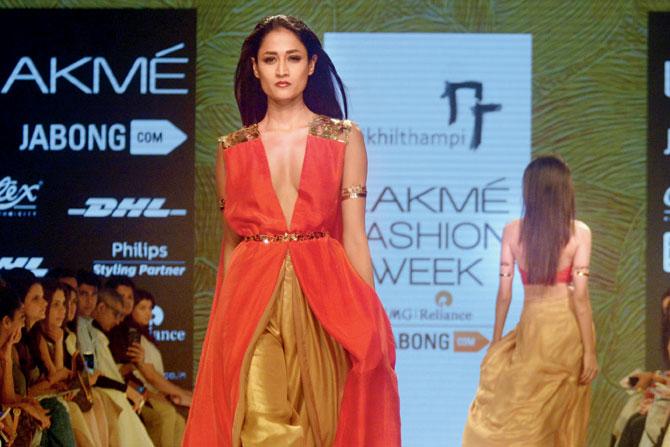
A model walks the ramp for Nikhil Thampi’s show on Wednesday in Toor’s footwear. There is a possibility that he’ll stock them in stores where his designs sell. PIC/PRADEEP DHIVAR
Where do those accessories come from, and how can you get them into your closet? Designers make their own, source them or collaborate on creating accessories for a show to tie up the looks in a nice neat visual package. But not all of them are produced in numbers large enough for sales, which makes that cuff or clutch more coveted.
Since his clothes are richly detailed, designer Nachiket Barve uses minimal accessories. “We team up with local karigars to make laser-cut acrylic cuffs, clutches or hand-cut stencilled brass mouth-pieces that look like a tattoo, like we did for Wills India Fashion Week Autumn/Winter 2014 Maori-themed collection,” he says. Since he hasn’t yet developed an accessory line for sale, these pieces are sold off the ramp on request or lent for fashion editorials.
 Collaborators Thampi and Toor
Collaborators Thampi and Toor
His approach to shoes is sensible; he likes them to be versatile, a design he can repeat for a few seasons. Models tend to have large feet (proportionate to their height); their shoe sizes range from 38 to 42. “I prefer them wearing shoes that complement the design rather than their own,” he says. “So, this time, we created simple black, faux leather sandals with a statement heel.” Couture designers like Shantanu and Nikhil design for functionality, even in bridal wear and know their clients like to buy the entire look — bespoke shoes, head gear, lace gloves included. “We make our own accessories and a prototype is available at each standalone store,” says Shantanu Mehra.
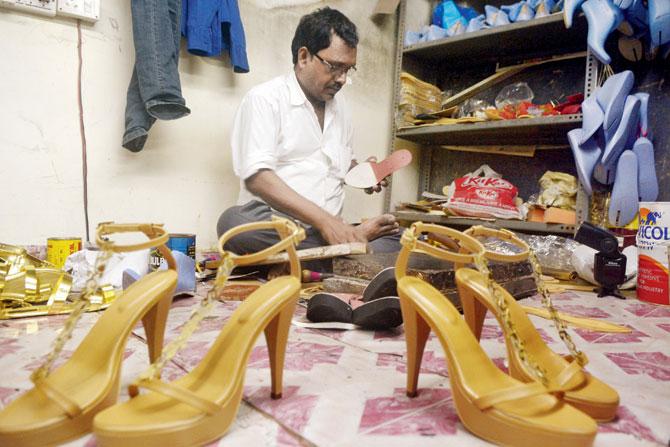
A karigar works on footwear for Thampi’s fashion week collection at Toor’s Sion factory. Pic/Pradeep Dhivar
Most times, a designer will collaborate with an accessory designer — either tweaking something from an existing collection; or requesting a fresh, complementary line. How much of this ‘collaboration’ the clothes designer acknowledges depends on personal ethics.
When Nikhil Thampi and Aparajita Toor came together for the Lakmé Fashion Week Autumn/Winter 2015 line, Thampi enthusiastically acknowledged her. Toor is an old hand, having collaborated with Akaro, Love Birds, Neha Agarwal and Debarun Mukherjee and Masaba Gupta. Thampi discussed the arrangement on social media and there is a possibility of extending the partnership by stocking her shoes in stores where Thampi sells, or online. Toor made five-inch heels with a brass moulding in a gold tone that matched the embroidery.
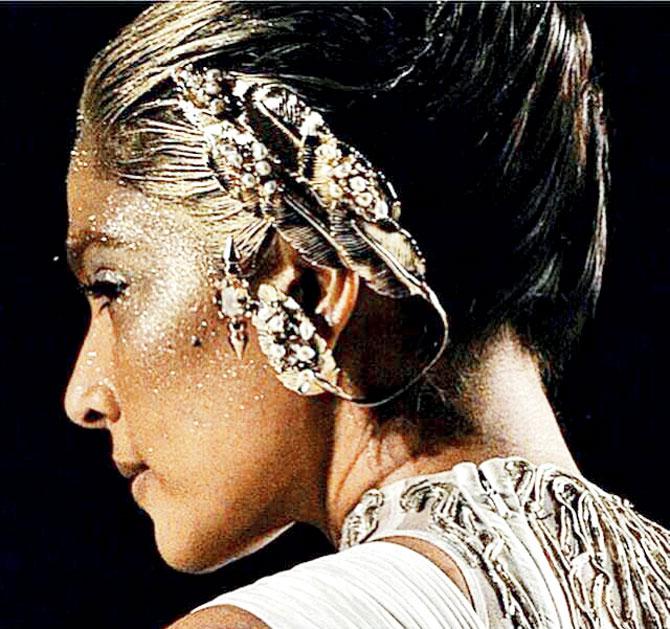
Kaabia Grewal’s Outhouse found a mention in Gaurav Gupta’s lookbook, and that proved to be a brand push
“When the design is complicated, and say, requires matching the exact shade of gold, or brass as in this case,” says Toor, “you need a designer who can communicate the specifics to a karigar. The pricing is a mutual decision, taken after considering my costs and the profile of Thampi’s clothes.”
Not all such partnerships are happy. “There’s only that much you can tell a designer to promote our work. Gaurav Gupta was a big push; he told everyone about us and stocked the pieces made for his collection at his stores. He had chosen existing pieces and we made a few new ones,” says Kaabia Grewal of Outhouse. The accessories designer is mentioned in Gupta’s press kit for Amazon Couture week 2015 and editors usually recognise the pieces. Canny store owners will buy the entire ‘look’ off the runway, stocking both clothes and jewellery in their stores.
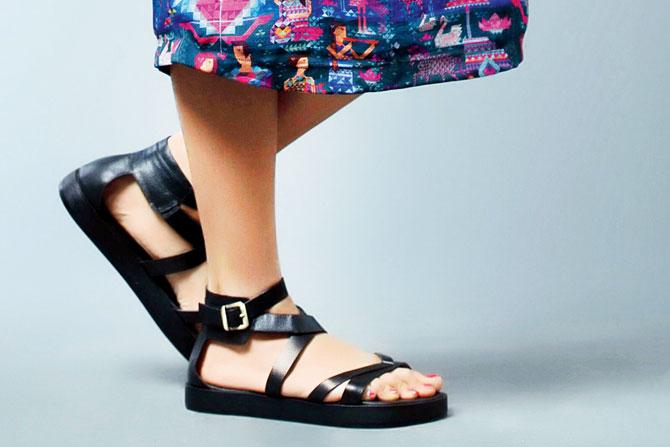 Naman Shah of Cuero, a Pune-based bespoke, made these leather sandals for Quirkbox’s show
Naman Shah of Cuero, a Pune-based bespoke, made these leather sandals for Quirkbox’s show
“On ramp, the accessories are layered for drama. Ramp shows are great. You can do anything you want,” explains Kaabia. “We made four prototypes for Tarun Tahiliani’s show at BMW Bridal Week in August 2014. Those we keep for sending out for window displays or editorials in fashion magazines. Often we take them apart to see how we can retain some elements but tone down the drama to better wearability at say, a sangeet or wedding.”
Outhouse does not give away design rights to its designers — ear cuffs, maang-mohawks, headgear and hand harnesses — which allows them control over pricing and where they wish to sell their work. “This is important because we want to make a profit without making our stuff so expensive that patrons think twice.”
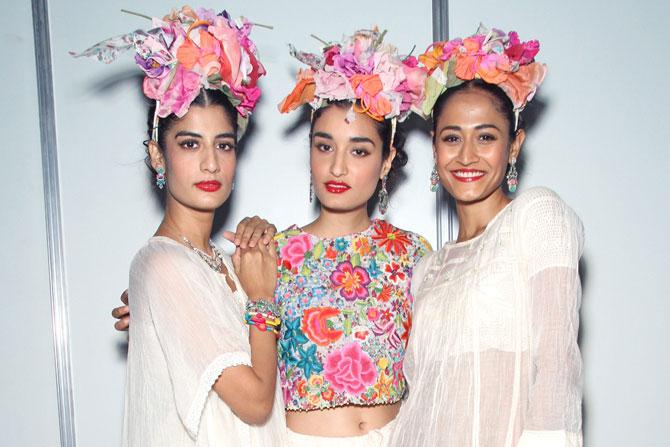
Péro models in embroidered keds
For accessory designers, collaborating with a fashion head is a good chance to feel their way around fashion weeks. They plug into the network and warm up before setting up stalls (an expensive ordeal) or showing on their own at a fashion show. The downside is relative invisibility and the many loopholes — for instance, since they are not “showing” directly at the fashion week, they cannot associate their collection with that season while promoting it online or offline.
Naman Shah of Cuero, a Pune-based bespoke, handmade shoe brand has partnered twice with Quirkbox. Though the brand focuses on men’s shoes, for LFW Winter/Festive 2014, they made 1960s-inspired curved block heels with tassels. This time, they made sophisticated leather sandals. “It translates into a lot of mileage among stylists who will source for shoots,” explains Shah. “There’s traction on social media, we get access to pictures and Quirkbox sold them at their store. If the shoes are sold fresh off the ramp, the designer keeps a percentage. Otherwise, they become our property. I am free to make them under my label and sell. The designer of course, retains copyright over fabric — if it’s a special print they’ve made, I can’t use it.”
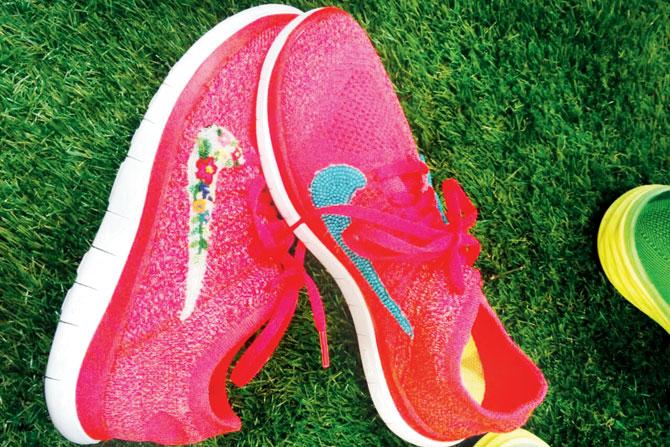 Aneeth Arora got Nike shoes embroidered for her Wills India Fashion Week Spring/Summer 2015 show
Aneeth Arora got Nike shoes embroidered for her Wills India Fashion Week Spring/Summer 2015 show
Péro welds sourced goods and personalisation into their “upcycled” projects. So popular are their accessories that stylists will request the “whole look” for a magazine shoot, but often ending up using the accessories.
Some collaborations are “silent” as Péro’s creator Aneeth Arora puts it, like the Nike shoes she bought and embroidered for her Wills India Fashion Week Spring/Summer 2015 show. Others are overt, like the Gigi (an Italy-based brand) military hats made out of Péro fabric for the Fall/Winter 2015 and the leather boots from Florentini+Baker with hearts sewn on them. “Often, models end up buying shoes off the ramp since it’s hard to get their sizes in India,” she says. Whether she sells the accessory off the ramp depends on if it can be quickly reproduced to be used later. Pricing calculations are done on-spot.
 Aneeth Arora Pic/Sachin Soni
Aneeth Arora Pic/Sachin Soni
How coveted is a seemingly tiny piece of embellishment? For Fall/Winter 2015 Péro showcased dolls made by Princess Pea wearing Péro dresses. Even those were lapped up post show and used to decorate bags and scarves.
 Subscribe today by clicking the link and stay updated with the latest news!" Click here!
Subscribe today by clicking the link and stay updated with the latest news!" Click here!







